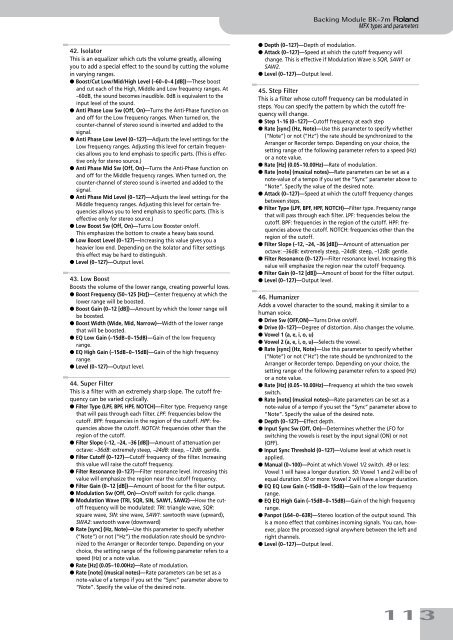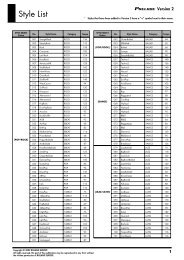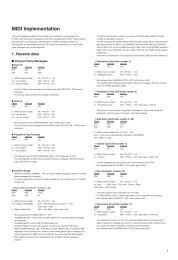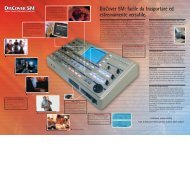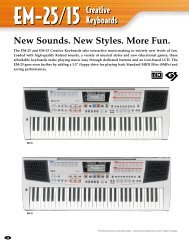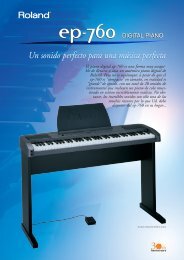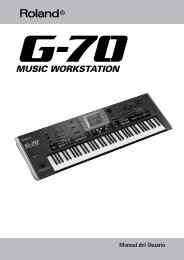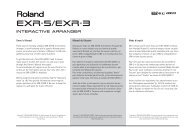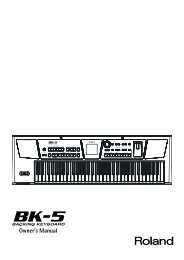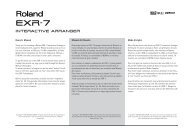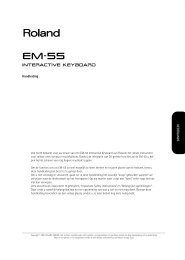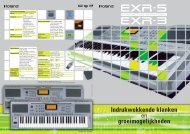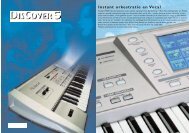BK-7m_OM.pdf - Roland
BK-7m_OM.pdf - Roland
BK-7m_OM.pdf - Roland
Create successful ePaper yourself
Turn your PDF publications into a flip-book with our unique Google optimized e-Paper software.
Backing Module <strong>BK</strong>-<strong>7m</strong> r<br />
MFX types and parameters<br />
42. Isolator<br />
This is an equalizer which cuts the volume greatly, allowing<br />
you to add a special effect to the sound by cutting the volume<br />
in varying ranges.<br />
● Boost/Cut Low/Mid/High Level (–60~0~4 [dB])—These boost<br />
and cut each of the High, Middle and Low frequency ranges. At<br />
–60dB, the sound becomes inaudible. 0dB is equivalent to the<br />
input level of the sound.<br />
● Anti Phase Low Sw (Off, On)—Turns the Anti-Phase function on<br />
and off for the Low frequency ranges. When turned on, the<br />
counter-channel of stereo sound is inverted and added to the<br />
signal.<br />
● Anti Phase Low Level (0~127)—Adjusts the level settings for the<br />
Low frequency ranges. Adjusting this level for certain frequencies<br />
allows you to lend emphasis to specific parts. (This is effective<br />
only for stereo source.)<br />
● Anti Phase Mid Sw (Off, On)—Turns the Anti-Phase function on<br />
and off for the Middle frequency ranges. When turned on, the<br />
counter-channel of stereo sound is inverted and added to the<br />
signal.<br />
● Anti Phase Mid Level (0~127)—Adjusts the level settings for the<br />
Middle frequency ranges. Adjusting this level for certain frequencies<br />
allows you to lend emphasis to specific parts. (This is<br />
effective only for stereo source.)<br />
● Low Boost Sw (Off, On)—Turns Low Booster on/off.<br />
This emphasizes the bottom to create a heavy bass sound.<br />
● Low Boost Level (0~127)—Increasing this value gives you a<br />
heavier low end. Depending on the Isolator and filter settings<br />
this effect may be hard to distinguish.<br />
● Level (0~127)—Output level.<br />
43. Low Boost<br />
Boosts the volume of the lower range, creating powerful lows.<br />
● Boost Frequency (50~125 [Hz])—Center frequency at which the<br />
lower range will be boosted.<br />
● Boost Gain (0~12 [dB])—Amount by which the lower range will<br />
be boosted.<br />
● Boost Width (Wide, Mid, Narrow)—Width of the lower range<br />
that will be boosted.<br />
● EQ Low Gain (–15dB~0~15dB)—Gain of the low frequency<br />
range.<br />
● EQ High Gain (–15dB~0~15dB)—Gain of the high frequency<br />
range.<br />
● Level (0~127)—Output level.<br />
44. Super Filter<br />
This is a filter with an extremely sharp slope. The cutoff frequency<br />
can be varied cyclically.<br />
● Filter Type (LPF, BPF, HPF, NOTCH)—Filter type. Frequency range<br />
that will pass through each filter. LPF: frequencies below the<br />
cutoff. BPF: frequencies in the region of the cutoff. HPF: frequencies<br />
above the cutoff. NOTCH: frequencies other than the<br />
region of the cutoff.<br />
● Filter Slope (–12, –24, –36 [dB])—Amount of attenuation per<br />
octave: –36dB: extremely steep, –24dB: steep, –12dB: gentle.<br />
● Filter Cutoff (0~127)—Cutoff frequency of the filter. Increasing<br />
this value will raise the cutoff frequency.<br />
● Filter Resonance (0~127)—Filter resonance level. Increasing this<br />
value will emphasize the region near the cutoff frequency.<br />
● Filter Gain (0~12 [dB])—Amount of boost for the filter output.<br />
● Modulation Sw (Off, On)—On/off switch for cyclic change.<br />
● Modulation Wave (TRI, SQR, SIN, SAW1, SAW2)—How the cutoff<br />
frequency will be modulated: TRI: triangle wave, SQR:<br />
square wave, SIN: sine wave, SAW1: sawtooth wave (upward),<br />
SWA2: sawtooth wave (downward)<br />
● Rate [sync] (Hz, Note)—Use this parameter to specify whether<br />
(“Note”) or not (“Hz”) the modulation rate should be synchronized<br />
to the Arranger or Recorder tempo. Depending on your<br />
choice, the setting range of the following parameter refers to a<br />
speed (Hz) or a note value.<br />
● Rate [Hz] (0.05~10.00Hz)—Rate of modulation.<br />
● Rate [note] (musical notes)—Rate parameters can be set as a<br />
note-value of a tempo if you set the “Sync” parameter above to<br />
“Note”. Specify the value of the desired note.<br />
● Depth (0~127)—Depth of modulation.<br />
● Attack (0~127)—Speed at which the cutoff frequency will<br />
change. This is effective if Modulation Wave is SQR, SAW1 or<br />
SAW2.<br />
● Level (0~127)—Output level.<br />
45. Step Filter<br />
This is a filter whose cutoff frequency can be modulated in<br />
steps. You can specify the pattern by which the cutoff frequency<br />
will change.<br />
● Step 1~16 (0~127)—Cutoff frequency at each step<br />
● Rate [sync] (Hz, Note)—Use this parameter to specify whether<br />
(“Note”) or not (“Hz”) the rate should be synchronized to the<br />
Arranger or Recorder tempo. Depending on your choice, the<br />
setting range of the following parameter refers to a speed (Hz)<br />
or a note value.<br />
● Rate [Hz] (0.05~10.00Hz)—Rate of modulation.<br />
● Rate [note] (musical notes)—Rate parameters can be set as a<br />
note-value of a tempo if you set the “Sync” parameter above to<br />
“Note”. Specify the value of the desired note.<br />
● Attack (0~127)—Speed at which the cutoff frequency changes<br />
between steps.<br />
● Filter Type (LPF, BPF, HPF, NOTCH)—Filter type. Frequency range<br />
that will pass through each filter. LPF: frequencies below the<br />
cutoff. BPF: frequencies in the region of the cutoff. HPF: frequencies<br />
above the cutoff. NOTCH: frequencies other than the<br />
region of the cutoff.<br />
● Filter Slope (–12, –24, –36 [dB])—Amount of attenuation per<br />
octave: –36dB: extremely steep, –24dB: steep, –12dB: gentle.<br />
● Filter Resonance (0~127)—Filter resonance level. Increasing this<br />
value will emphasize the region near the cutoff frequency.<br />
● Filter Gain (0~12 [dB])—Amount of boost for the filter output.<br />
● Level (0~127)—Output level.<br />
46. Humanizer<br />
Adds a vowel character to the sound, making it similar to a<br />
human voice.<br />
● Drive Sw (OFF,ON)—Turns Drive on/off.<br />
● Drive (0~127)—Degree of distortion. Also changes the volume.<br />
● Vowel 1 (a, e, i, o, u)<br />
● Vowel 2 (a, e, i, o, u)—Selects the vowel.<br />
● Rate [sync] (Hz, Note)—Use this parameter to specify whether<br />
(“Note”) or not (“Hz”) the rate should be synchronized to the<br />
Arranger or Recorder tempo. Depending on your choice, the<br />
setting range of the following parameter refers to a speed (Hz)<br />
or a note value.<br />
● Rate [Hz] (0.05~10.00Hz)—Frequency at which the two vowels<br />
switch.<br />
● Rate [note] (musical notes)—Rate parameters can be set as a<br />
note-value of a tempo if you set the “Sync” parameter above to<br />
“Note”. Specify the value of the desired note.<br />
● Depth (0~127)—Effect depth.<br />
● Input Sync Sw (Off, On)—Determines whether the LFO for<br />
switching the vowels is reset by the input signal (ON) or not<br />
(OFF).<br />
● Input Sync Threshold (0~127)—Volume level at which reset is<br />
applied.<br />
● Manual (0~100)—Point at which Vowel 1/2 switch. 49 or less:<br />
Vowel 1 will have a longer duration. 50: Vowel 1 and 2 will be of<br />
equal duration. 50 or more: Vowel 2 will have a longer duration.<br />
● EQ EQ Low Gain (–15dB~0~15dB)—Gain of the low frequency<br />
range.<br />
● EQ EQ High Gain (–15dB~0~15dB)—Gain of the high frequency<br />
range.<br />
● Panpot (L64~0~63R)—Stereo location of the output sound. This<br />
is a mono effect that combines incoming signals. You can, however,<br />
place the processed signal anywhere between the left and<br />
right channels.<br />
● Level (0~127)—Output level.<br />
113


